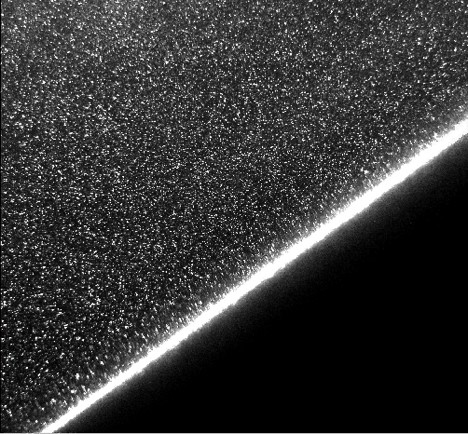 AUSTIN, Texas—A class of powerful, invisible waves hidden beneath the surface of the ocean can shape the underwater edges of continents and contribute to ocean mixing and climate, researchers from The University of Texas at Austin have found.
AUSTIN, Texas—A class of powerful, invisible waves hidden beneath the surface of the ocean can shape the underwater edges of continents and contribute to ocean mixing and climate, researchers from The University of Texas at Austin have found.
The scientists simulated ocean conditions in a laboratory aquarium and found that “internal waves” generate intense currents when traveling at the same angle as that of the continental slope. The continental slope is the region where the relatively shallow continental shelf slants down to meet the deep ocean floor.
They suspect that these intense currents, called boundary flows, lift sediments as the waves push into the continental slope, maintaining the angle of the slope through erosion. The action of the internal waves could also mix layers of colder and warmer water.
“Surprisingly little is known about how internal waves are generated and how they could lead to the mixing of the deep ocean, but it’s very important,” said physicist Hepeng Zhang. “Understanding ocean mixing is crucial for us to know whether changes in ocean circulation are the result of climate change or just variability.”
Zhang said that as long as there is tidal motion that generates internal waves traveling along the continental slope, intense boundary flow will be produced.
“Twenty-four hours a day, seven days a week over a long geological time scale, and this will maintain the angle of the continental slope,” he said.
He published his research with colleagues Harry Swinney and Benjamin King in Physical Review Letters.
Zhang studied internal waves using a simple saltwater aquarium equipped with a sloping bottom simulating the continental slope. Water in the tank increased in density from top to bottom, just as water is denser on the ocean floor. Thousands of very small particles, 10 microns or smaller, were suspended in the water.
As Zhang generated waves in the tank, he took photographs and video footage of the particles and then analyzed the particles’ direction of flow and velocity.
Particle motion revealed intense boundary flows when the angle of the bottom matched the angle at which internal waves can travel.
Oceanic continental slopes could theoretically reach angles of 15 to 20 degrees as sediments continually pour down from the continents, but Zhang said that the internal waves are limiting the angle to around three degrees, the average angle of continental slopes.
The internal waves could also play a role in larger ocean currents by bringing cold water up from the deep ocean to the surface at the equator.
Ocean currents form closed loops, with warm surface water, like the Gulf Stream, moving toward the poles and cold water circulating back toward the equator at depth. The warm surface water heated at the equator is largely driven to the poles by wind. At the poles, this water is cooled by the cold air and mixes with cold water from melting glaciers and ice. Although fresh water is less dense than sea water, the cooling effect wins out and the density increases until the water sinks.
Zhang found that the internal waves could help bring this cold water closer to the surface when the boundary flow pushes heavier, colder water over warmer lighter water on the continental slope. This results in the internal wave breaking and mixing on the slope, just as a surface wave breaks on the shore.
“How exactly this will contribute to ocean circulation, I really don’t know,” said Zhang. “But it is definitely a step we have to understand before we can understand global ocean circulation.”

















Comments